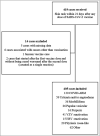Cutaneous reactions after SARS-CoV-2 vaccination: a cross-sectional Spanish nationwide study of 405 cases
- PMID: 34254291
- PMCID: PMC8444756
- DOI: 10.1111/bjd.20639
Cutaneous reactions after SARS-CoV-2 vaccination: a cross-sectional Spanish nationwide study of 405 cases
Abstract
Background: Cutaneous reactions after severe acute respiratory syndrome coronavirus 2 (SARS-CoV-2) vaccines are poorly characterized.
Objective: To describe and classify cutaneous reactions after SARS-CoV-2 vaccination.
Methods: A nationwide Spanish cross-sectional study was conducted. We included patients with cutaneous reactions within 21 days of any dose of the approved vaccines at the time of the study. After a face-to-face visit with a dermatologist, information on cutaneous reactions was collected via an online professional survey and clinical photographs were sent by email. Investigators searched for consensus on clinical patterns and classification.
Results: From 16 February to 15 May 2021, we collected 405 reactions after vaccination with the BNT162b2 (Pfizer-BioNTech; 40·2%), mRNA-1273 (Moderna; 36·3%) and AZD1222 (AstraZeneca; 23·5%) vaccines. Mean patient age was 50·7 years and 80·2% were female. Cutaneous reactions were classified as injection site ('COVID arm', 32·1%), urticaria (14·6%), morbilliform (8·9%), papulovesicular (6·4%), pityriasis rosea-like (4·9%) and purpuric (4%) reactions. Varicella zoster and herpes simplex virus reactivations accounted for 13·8% of reactions. The COVID arm was almost exclusive to women (95·4%). The most reported reactions in each vaccine group were COVID arm (mRNA-1273, Moderna, 61·9%), varicella zoster virus reactivation (BNT162b2, Pfizer-BioNTech, 17·2%) and urticaria (AZD1222, AstraZeneca, 21·1%). Most reactions to the mRNA-1273 (Moderna) vaccine were described in women (90·5%). Eighty reactions (21%) were classified as severe/very severe and 81% required treatment.
Conclusions: Cutaneous reactions after SARS-CoV-2 vaccination are heterogeneous. Most are mild-to-moderate and self-limiting, although severe/very severe reactions are reported. Knowledge of these reactions during mass vaccination may help healthcare professionals and reassure patients.
© 2021 British Association of Dermatologists.
Figures
Comment in
-
COVID-19 vaccines and skin manifestations.Br J Dermatol. 2022 Jan;186(1):15. doi: 10.1111/bjd.20807. Epub 2021 Nov 2. Br J Dermatol. 2022. PMID: 34726781 Free PMC article.
References
-
- Phelan AL, Katz R, Gostin LO. The novel coronavirus originating in Wuhan, China: challenges for global health governance. JAMA 2020; 323:709–10. - PubMed
-
- World Health Organization . Draft landscape of COVID‐19 candidate vaccines – 20 March 2020. Available at: https://www.who.int/blueprint/priority‐diseases/key‐action/novel‐coronav... (last accessed 20 July 2021).
-
- Krammer F. SARS‐CoV‐2 vaccines in development. Nature 2020; 586:516–27. - PubMed



